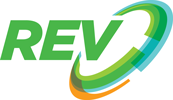By Scott Bowman
Helping companies to develop robust sustainability action plans is the core of the REV Sustainability Circle® program. There is another prominent national organization that focuses on sustainability — the US Green Building Council, or USGBC and their Leadership in Energy and Environmental Design (LEED) standards. Many people know of USGBC and LEED, but there is often confusion about how REV can work with LEED within the Sustainability Circle.
 First, some background on LEED and how it can work well as part of a sustainability action plan. LEED is a suite of standards that are aligned and focused on different aspects of the built environment. This is one key difference from the REV curriculum — while the Sustainability Circle program covers a wide range of areas, LEED focuses solely on buildings (with minor nuances not worth explaining here). Buildings are a big part of the environmental footprint of a company, but hardly the largest, especially in an industrial setting. Second, LEED is a standard, a way to measure sustainability and performance metrics against a scale that can then be compared to other buildings. This means that a company must have a building to use LEED.
First, some background on LEED and how it can work well as part of a sustainability action plan. LEED is a suite of standards that are aligned and focused on different aspects of the built environment. This is one key difference from the REV curriculum — while the Sustainability Circle program covers a wide range of areas, LEED focuses solely on buildings (with minor nuances not worth explaining here). Buildings are a big part of the environmental footprint of a company, but hardly the largest, especially in an industrial setting. Second, LEED is a standard, a way to measure sustainability and performance metrics against a scale that can then be compared to other buildings. This means that a company must have a building to use LEED.
REV programs guide organizations to develop sustainability action plans that address many aspects of their business — from employee engagement and procurement to waste, water, and energy, and including buildings. This holistic approach to sustainability provides a foundation that strengthens a program within a company and leads to extraordinary results. LEED fits perfectly as one tool, or initiative, that can be used in an overall plan, providing recognition of performance and leadership in the built environment.
 REV and LEED both organize sustainability into groups of topics. LEED is more formal, providing credits and points for specific metrics. While some Sustainability Circle participating organizations are building new buildings or finishing a new tenant space, most are dealing with existing buildings. This means that LEED for Existing Buildings, Operations and Maintenance (EBOM – pronounced “E-Bomb” by those in the know) is one of the best standards that align with Sustainability Circle action planning since nearly every sustainability action plan includes initiatives related to buildings and the operation of those buildings. For some organizations, these might be some of their larger initiatives, both in affect (reducing energy, water, or waste) and cost (investment).
REV and LEED both organize sustainability into groups of topics. LEED is more formal, providing credits and points for specific metrics. While some Sustainability Circle participating organizations are building new buildings or finishing a new tenant space, most are dealing with existing buildings. This means that LEED for Existing Buildings, Operations and Maintenance (EBOM – pronounced “E-Bomb” by those in the know) is one of the best standards that align with Sustainability Circle action planning since nearly every sustainability action plan includes initiatives related to buildings and the operation of those buildings. For some organizations, these might be some of their larger initiatives, both in affect (reducing energy, water, or waste) and cost (investment).
One concept that REV emphasizes in the education process is the need to measure results, celebrate, and be recognized for success. As one of the world’s most widely used and recognized third-party verifications for green buildings, LEED certification is a great way to display significant achievements in sustainability. EBOM is also a great way to organize, manage, and track those initiatives in a sustainability action plan that relates to a building. The process of EBOM is not a onetime task — it takes dedication, organization, and time to implement and gain certification. Once certified, a building must be renewed on a regular basis, which again gives strong support and incentives to ongoing efforts and resilience in a company’s program.
There are many coaches in REV that are quite knowledgeable about LEED and EBOM and can lead you to more information and answer your questions. Typically, the first step toward EBOM is to engage a LEED Consultant or other professional with experience to do a gap analysis. A modest investment in this analysis can provide more detailed information on where a company is, what additional investment may be, and how to integrate initiatives into the certification process.
REV and LEED are meant for each other! Feel free to contact me if you have any questions.
Scott BOWMAN, PE, LEED BD+C, LEED Fellow
[email protected]
515.314.3788


